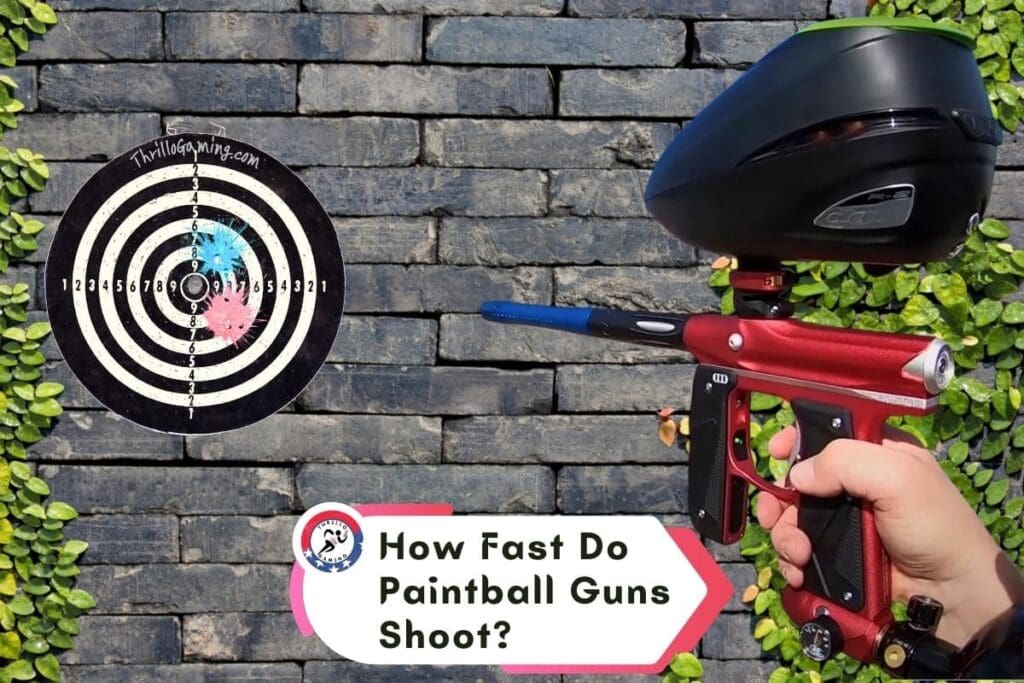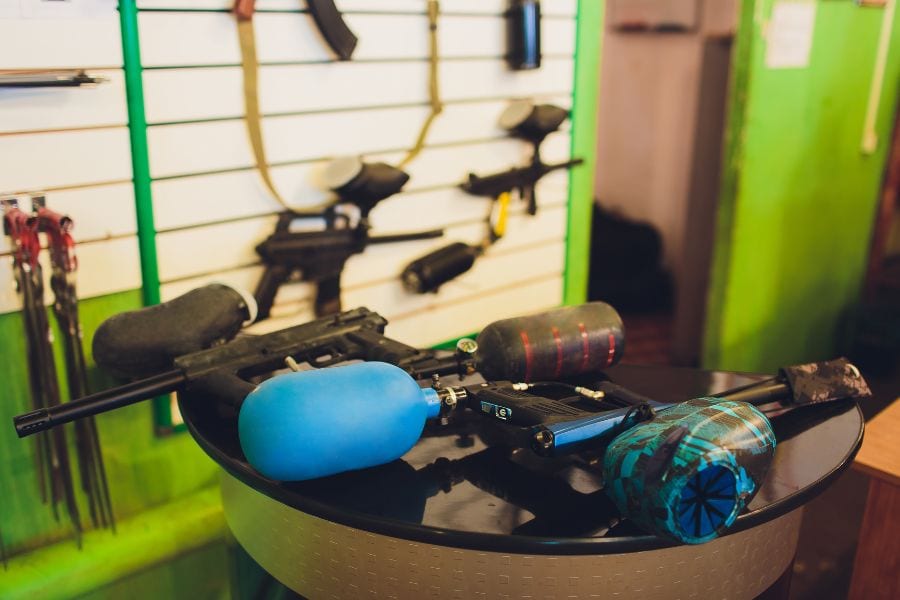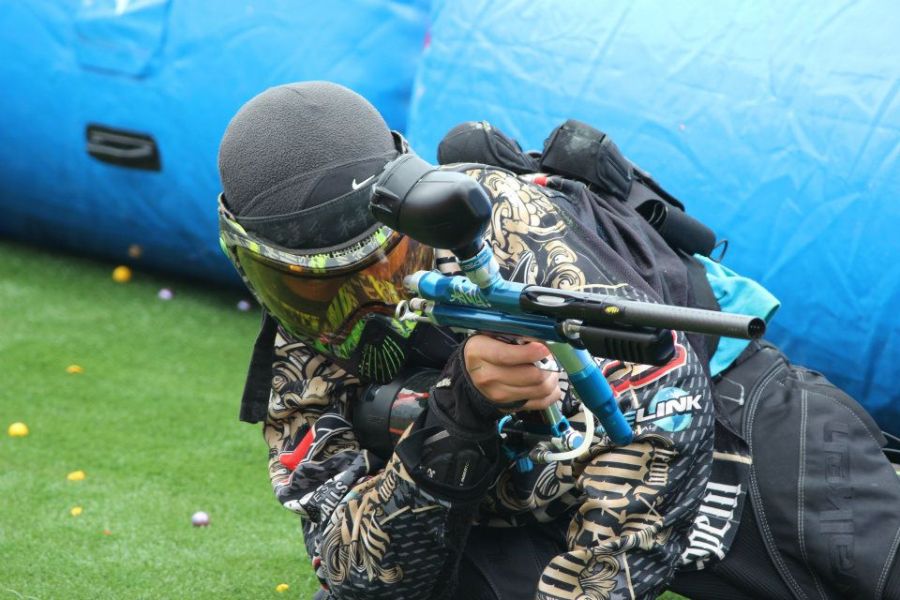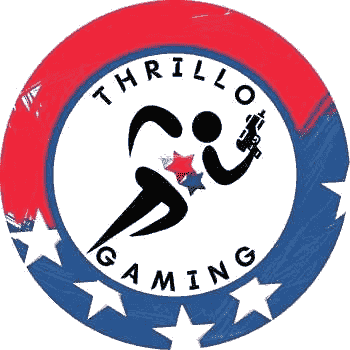In my early gaming days, I often found myself intrigued by the SHOOTING SPEED of paintball guns. This was back when I relied on the markers provided at arenas before getting my own. It wasn’t until I asked one of the staff at an arena that I learned all guns there were set to shoot at 280 feet per second (FPS). But, that was just like the tip of an iceberg!
Fast-forwarding a decade, I am now a hardcore paintballer with an ever-increasing arsenal of speedball and woodsball guns. What’s truly intriguing is how the MUZZLE VELOCITY varies from one gun to another, with many markers even allowing for adjustable speeds and firing rates.
If you’re new to the game and curious about how fast a paintball gun shoots, I’ve got all the insights backed by my years of experience! I’ll also cover how you can measure and adjust the velocity, along with some essential tips to enhance your experience.

Speed Limit Of Paintball Guns: How Fast Do They Shoot?
While the muzzle velocity of a marker varies from one to another, most of them shoot somewhere between 250 FPS and 300 FPS. Some of the best paintball guns, like the Empire Axe 2.0, Dye Rize CZR, and Tippmann Stormer Elite, are more powerful, faster, and can reach a speed of up to 325 FPS.
Here’s a chart detailing the speed limits of markers in FPS (Feet per Second), MPH (Miles per Hour), and KMPH (Kilometers per Hour). As a rule of thumb, you can convert muzzle velocity from FPS to MPH and KMPH by multiplying it by a factor of 0.69 and 1.0973 respectively.
| FPS | MPH | KMPH |
|---|---|---|
| 250 | 170 | 274 |
| 280 | 190 | 307 |
| 300 | 204 | 329 |
| 325 | 221 | 439 |
Before purchasing paintball markers, I always thoroughly review all the performance specs and personally test each gun. Call me a nerd, but I love delving into every detail I get my hands on.
In my experience, 325 FPS is typically the MAXIMUM velocity you can achieve with any stock paintball gun before modifications. However, with a custom-built gun or upgrades to a marker, you can exceed this limit. For example, I helped my friend Jeremy upgrade his Tippmann Stormer Elite, raising its shooting speed to 350 FPS.
I once watched a video where someone managed to clock a muzzle velocity of 677 FPS (462 MPH) on a different gun, showing that it’s possible to significantly exceed the stock limit of your paintball marker.
Factors That Affect The Shooting Speed
Speed is a crucial factor in the game of paintball, influencing the trajectory and impact of each shot. To maximize your performance on the field, it’s important to understand the various factors that can affect the speed of your paintball gun. Let’s take a closer look at these key factors:
Compressed Gas Pressure: The pressure in the marker’s air tank or CO2 canister affects the propulsion of paintballs. Higher pressure typically results in higher velocity.
Valve System: The type of paintball gun and its valve system can impact speed. For example, guns with electronic solenoid valves can achieve higher rates of fire compared to mechanical guns.
Barrel Length and Bore Size: The length and bore size of the barrel can affect the velocity of the paintball. A longer barrel may provide more acceleration time, resulting in higher speeds.
Paintball Size and Weight: The size and weight of the paintball can affect its pace. Heavier paintballs may not accelerate as quickly as lighter ones.
Regulator Settings: The regulator controls the pressure of the air released into the gun. Adjusting the regulator can impact the speed of the paintball.
Bolt and Spring Tension: The tension of the bolt and spring inside the gun can affect how quickly the gun cycles and therefore how fast it shoots.
Temperature: Temperature can impact the pressure inside the air tank or CO2 canister, affecting the shooting speed of markers.
Paintball Quality: The quality and condition of the paintballs themselves can affect their velocity. Old or misshapen paintballs may not shoot as fast or accurately.
How Can You Measure The Velocity Of Paintballs?
Using a CHRONOGRAPH device is the easiest and most effective way to measure the shooting speed of your paintball gun. Initially, I used to test my markers at the local arena. However, as I began customizing my guns and needed to gauge muzzle velocity more frequently, I invested in an X-Radar paintball chronograph, which also included a rate of fire counter as a bonus.
My testing setup is simple: a chronograph to measure muzzle velocity and rate of fire, and a variety of bottles and cans set up at different distances in my backyard to test the range and accuracy of markers.
To use the device, simply hold it at the end of the gun barrel, positioning the sensor so that the paint balls pass close enough to gauge the speed. Although my X-Radar Chronograph is handheld, I prefer to place it on a stable surface to ensure accurate measurements.
The digital screen instantly displays the FPS reading when you fire a paintball over the sensor, making it straightforward. What’s more? When I start ramping or shooting in full-auto mode, the Chronograph displays the rate of fire.
What’s The Fastest Paintball Firing Rate?
Most paintball guns typically have a fire rate of 10 to 20 balls per second (BPS), but some high-end markers can exceed 30 rounds per second. One of my favorites, the Spyder Fenix, can deliver an impressive 25 BPS rate – the FASTEST I have seen so far. Paintball guns with high firing rates often feature an adjustment knob that allows you to set the desired limit.
It’s important to note that the rate of fire usually refers to a gun’s rate of fire in full-automatic shooting mode. It doesn’t matter as much for semi-automatic paintball guns since they fire as fast as you pull the trigger.
While professional players can sometimes achieve rates of up to 20 shots per second (my personal record is 14 BPS), it’s really challenging for beginners to shoot more than 10 rounds.
Modifying your paintball gun can significantly increase the rate of fire, potentially reaching up to 40 balls per second in full-auto mode. So, if you’re looking to up your game and make your shots count, tinkering with your marker’s settings could be just the ticket.
After all, who wouldn’t want to unleash a hail of paintballs on the opposing team?

How Fast Is Too Fast For Paintballing?
Upgrading your paintball gun to increase its shooting speed can be a great way to enhance your gameplay, as long as you approach it with care and responsibility. While 300 FPS is typically considered a SAFE LIMIT for playing, you can sometimes stretch it a bit for fast long-range shots.
Exceeding 300 FPS might be acceptable in certain arenas, but it’s usually reserved for experienced paintballers. I upgraded Jeremy’s Stormer Elite to increase its muzzle velocity because he excels as a sniper and could benefit from the added range.
Yet, beware! If you push your gun’s velocity too far in the heat of the game, you risk causing harm to fellow players or worse, INJURIES. That’s precisely why paintball venues enforce strict speed regulations, ensuring a level playing field with all markers set to identical velocities.
While some high-end paintball guns can reach a firing speed of 325 FPS, it’s generally safer to keep them below 300 FPS. Even though paint balls are non-lethal, they can cause bruising and welts if the speed is too high, especially at close range.
I’ve personally experimented with pushing my paintball guns to the limit, even hitting 400 FPS on occasion, but strictly for experimental or long-range target practice. In actual matches, I adhere to the speed limit, ensuring I never exceed 300 FPS in a match. Safety first, always!
How Hard Does A Paintball Hit You With Such A Speed?
When it comes to the impact of paintball hits, it can vary based on several factors. I still remember my first paintball game a decade ago, when I came to the field wearing shorts for the first time.
The organizers warned me, but noticing my immense interest in the game, they provided me with a vest, a face mask, and a marker (capped at 280 FPS) to play with my friends.
Surprisingly, the first few hits were hardly noticeable against my thick armor. However, everything changed when a shot hit my exposed leg from close range.
The sudden, sharp pain made me jump up with a loud yelp, showing me just how hard the paint pellets can hit. This experience taught me a valuable lesson: always wear FULL-LENGTH combat paintball pants.
But that’s not all; several factors influence the force of the impact:
- Muzzle Velocity: The speed at which a paintball leaves the barrel directly affects how hard it hits. Many arenas limit the maximum muzzle velocity to 280-300 FPS (feet per second) to prevent ballers from getting hurt.
- Distance: As with any projectile, a paintball loses momentum the farther it travels. At long shooting ranges, they don’t hurt as much as they do at close range.
- Clothing / Protection: Whether your skin is exposed or protected can significantly impact the sensation of being hit. While you don’t need a full suit of armor, wearing full-length clothing and a full-face mask can make a big difference. The extra layer of clothing helps absorb the impact, reducing the sting.

Does A Faster Paintball Marker Mean Better Accuracy?
Although a faster paintball gun doesn’t inherently promise more accuracy, I’ve found that muzzle velocity does play a crucial role. This is because the speed at which a ball exits the barrel impacts its ability to maintain MOMENTUM and TRAJECTORY by overcoming air resistance.
At lower shooting speeds, paint balls are prone to quickly curving downward due to gravity, which limits their range. Additionally, factors like the quality of the pellets, barrel length, wind conditions, and even recoil can influence a marker’s accuracy.
Also Read: How Does A Paintball Gun Work?
Tips To Play Safe In High-Speed Paintball Action
Speedball and other fast-paced paintball games can be thrilling but also come with risks, especially for newcomers. Here are some quick tips to stay safe during intense games:
- Keep the muzzle velocity around 280 FPS, especially for close-range battles or when playing with beginners.
- Always wear eye protection, such as a paintball helmet or full-face mask, to shield your face.
- While speedball involves lots of movement, watch your step to avoid tripping or colliding with others.
- Stick to aiming and shooting only; avoid physical contact like shoving or grabbing other players’ markers.
- Lastly, respect the paintball rules and regulations—they’re there for everyone’s safety and enjoyment.
So, that’s the scoop: the highest muzzle velocity you can get on a stock paintball gun is around 325 FPS, while the allowable limit is 300 FPS in most facilities. But hey, if you’re into pushing boundaries like I am, feel free to tinker and tweak your marker for more power and speed.
Just remember, safety first! It’s all about finding that sweet spot between performance and fun.

